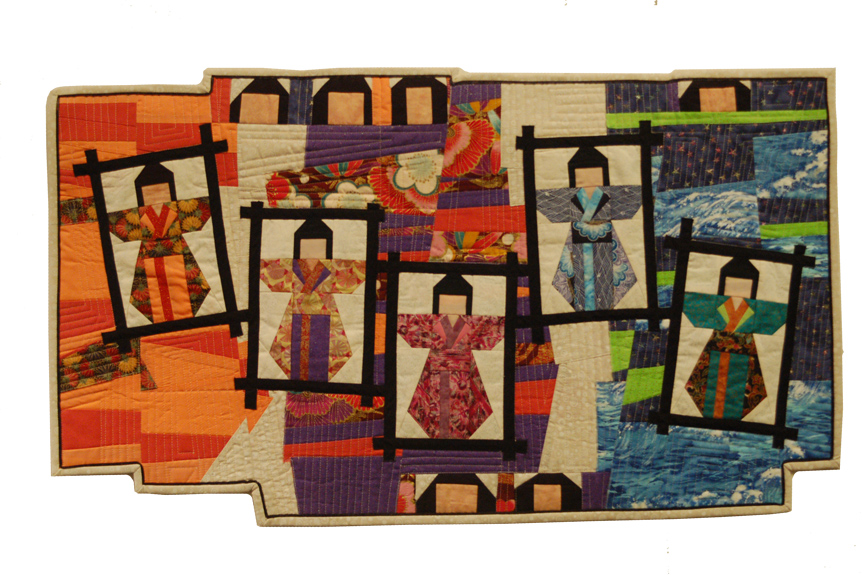Homer’s fiber artists can be found all over, at shows like Wearable Arts, in galleries and even in small couture shops. If you want to find the heart of the art and its historical center, look no further than the Pratt Museum.
Long a home to community quilters, who for decades have created raffle quilts like this year’s “From the Sky to the Sea,” through acquiring quilts for its collection and in shows like the 2007 exhibit, “Celebrating Quilts and Quilters,” the Pratt has examined quilts as a genuine art form.
“History in the Making: Quilts, Quilters and Their Stories,” a show open through Dec. 30, takes that idea further.
“It’s cohesive in theme, but there’s so much diversity in it,” said curator of exhibits Scott Bartlett, who put together the show. “It’s definitely crossing boundaries — quilts transformed into art quilts, and art quilts that have gone off on their own little thing.”
The idea of quilts as art also is looked at in a film shown Friday night at the Pratt, “The Great American Quilt Revival,” narrated by quilter Georgia Bonesteel, about how quilts came to be recognized as art. At 5 p.m. before the film is shown, the museum also holds a special showing of quilts from its collection.
In “Quilts, Quilters and Their Stories,” artists were invited to create works that reflect Kachemak Bay’s history and a quilter’s connection to the region. Quilters were asked to include a statement about their quilting history and the story of their piece. The Pratt got stories, but it also got a wide variety of techniques, forms and materials. One piece by Homer wood artist Deb Lowney, “A Place Called Homer,” isn’t even fabric, but wood, a sculpture of a quilt where sometimes people think “the quilt is real and made of cloth, not wood,” Lowney writes in her statement.
Using a 146-year-old spruce harvested in her back yard, Lowney’s work literally uses local materials. A cloth quilt, Rheta Kirk’s “Alaskan Beauties,” also does that, through a technique called “flower pounding.” On a trip through Alaska, Kirk collected flowers and plants, and gently tapped them with a hammer to release natural dyes that make impressions on fabric. She then embellished the images with stitching, beading and quilting.
Several pieces tell the story of Kachemak Bay’s ancient and modern cultures. Linda Shows Reinhart created “Anthropology 325” as a project in lieu of a term paper for a course taught by Dr. Alan Boraas at the Kachemak Bay Campus. A series of circles superimposed over a map of the lower Kenai Peninsula shows the people and cultures that have lived here from ancient to modern times. Bartlett hung her quilt suspended to show the back of it and display an aspect of the quilting technique.
“When quilters look at quilts, they often turn over the back,” he said. “It’s easy to see how the quilting is done.”
With Reinhart’s piece, on the back viewers get a bonus: an image of the Big Dipper and North Star — the Alaska flag — and a poem by the pioneer Kachemak Bay archaeologist Frederica de Laguna from her mystery novel, “The Arrow Points to Murder.”
“I was really pleasantly surprised by the reactions that piece got when it was hung,” Bartlett said. “They’d look around the back and go, ‘Oh, there’s a big dipper.’”
A quilt similar in theme is Ann-Lillian Crowell Schell’s “Mapping Alutiiq Heritage,” inspired by a talk by Dr. Aron Crowell at the 2011 Pratt Annual meeting. The work includes illustrations by Crowell ink-jet printed on muslin and appliquéd into the quilt.
A more abstract quilt, Nan Thompson’s “Tree of Life,” was done while she went through the transition from retired lawyer to artist, Thompson said. With its asymmetrical edges and form, the quilt shows the more impressionistic style of quilting, Bartlett said. It also shows how quilting and stitching, not just selection of fabric, is part of the technique.
“I think the quilting is the tree,” Bartlett said of the work. “The stitching itself, the quilting is a whole other pattern overall that can be used to superimpose those images.”
The quilters’ stories also inspire the art. Marilyn Kay Johnson’s “Empty Kimono’s: In Mother’s Memory,” came about from her weekly phone calls with her late mother, also a quilter. After her mother died, Johnson found two kimono clad figures done in a piecing technique she didn’t know. She taught herself the technique, but did it in her own style and as a memorial to her mother. She made an abstract background with an irregular edge, and in it put kimono figures “in frames, screens or coffins (you choose) and set them adrift through eternity accompanied by a chorus of bodiless heads,” Johnson writes.
Each quilt has an artist’s statement and story with the piece. They’re also collected in a booklet with images that can be browsed through at the show.
Pratt Museum director Diane Converse, also a quilter, said she had thought of entering the show, too, but didn’t have the time.
“As a quilter, I just love seeing them on our walls. I think it’s a really powerful form of art,” Converse said of the show. “I enjoy very much seeing them up, and I bask in that creativity.”
Quilt lovers who might want to take home some of that art can do so. Some works are on sale. The 2012 quilts, “From the Sky to the Sea,” and the smaller bonus quilt, “Iris,” can be bought for a $1 chance each — if you’re lucky. Tickets bought in a $10 lot of 12 chances also get a chance on the bonus quilt.
The drawing is Dec. 9 from 1 to 3 p.m. at a community recital at the museum.


